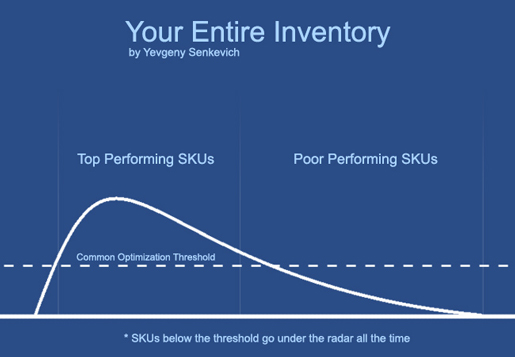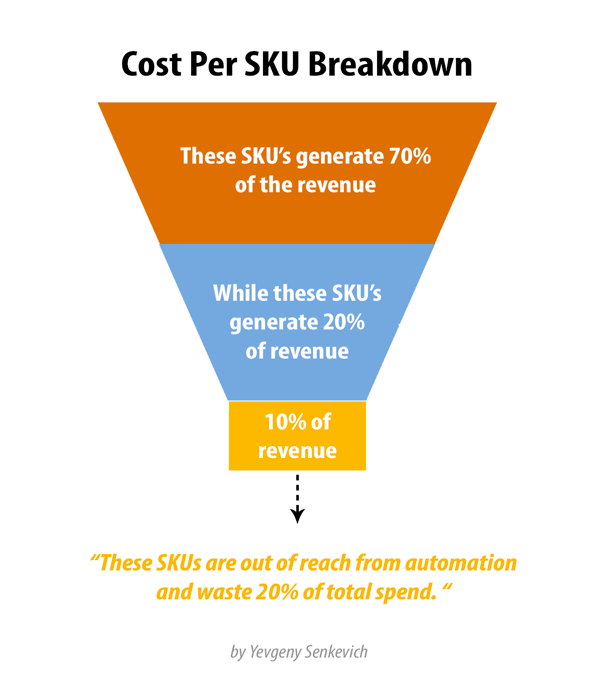Why Treat Each SKU as a Unique Business?

Most ecommerce stores and businesses consider growth online a big priority. They merchandise their way to inventory growth and online prosperity. These businesses that grow their stock into thousands of various SKUs must utilize an effective optimization strategy that expands with their business. They must treat each SKU as a unique business.
Profitable or unprofitable as it may be, each SKU provides a gain or a loss. The ideal scenario is to have a complete understanding on what the merchandise can bring to the table, and how various online marketing channels combine to measure a true margin.
True Margin
To measure true margin one would need to know their product cost and have enough data to measure online marketing profit and loss per SKU. Most ecommerce businesses consider the wrong KPIs. Marketing focuses on measuring digital marketing performance, and fulfillment has a focus on shipping and operational costs. Data needs to be shared between these two departments as far as costs are concerned. Combining these two costs resolves the separation issue between online marketing and fulfillment.
Combine Costs
Once the true cost has been established, business can understand how much money it is willing to pay per click. Most advanced ecommerce campaigns contain multiple channels through which they feed the paid engine of growth. Without considering product cost alongside marketing cost, this data will never reveal what is really going on below the hood. Sometimes numbers can be deceiving if one uses the wrong KPIs to measure performance.
Beneath the Surface
Marketing professionals consider high margin products to be more valuable. Focusing on the high margin brands and SKUs allows for budget floor and ceiling measurements. Marketing feels it has been successful if it spent $1 for every $1.50 in online revenue return. This is great news and the side effect of a profitable online campaign. However, the product cost may be $0.75 for this particular SKU, and when added into this equation puts the business at a loss. In this case the marketing cost must be minimized to get a positive return, otherwise the product may not be fit for paid advertising.

Good Cost vs. Bad Cost
As these metrics begin to find their positive growth mediums, each SKU will stabilize and contribute to the entire store. The rest of the time is spent on reducing ineffective SKUs to pennies and increasing bids for effective SKUs which drive most of the business. Most of the inventory in a typical ecommerce warehouse does not sell well, a small percentage carry all the weight. Using an example online store, 30 percent of all inventory generates 70 percent of the revenue. The other 70 percent of the inventory in stock is responsible for 30 percent of revenue, and in some cases for 50 percent of the entire marketing spend. These long tail SKUs can be slowly sinking the whole ship.

Lifetime Value of a SKU
The final factor of measuring the true margin revolves around lifetime value. Measuring lifetime value of a customer reveals how each SKU is referring additional value long after the first transaction. It may still be profitable to lose money on the initial transaction and make profit on return business. The only way to know what each SKU really contributes is to measure the entire lifetime profit and loss accurately. SKUs can help sell other SKUs and assist in multiple transactions which do not include the actual SKU marketed. Building out these metrics carefully is the key to understanding the true value and margin.
Death by a Thousand Cuts
As these SKUs begin to separate, one must use the true margin as a line drawn between bad cost and good cost. This is where knowing the true margin comes in handy. Focusing on SKUs which result in a loss causes a drop to cost per acquisition. Most automated software can not go down this far, as this is upfront and personal with the SKU. Thousands of SKUs are slowly eating away at retailers' marketing budgets one click at a time while going unnoticed. Many SKUs are slow movers and waste clicks in slow motion. It may take six months to get 15 clicks. Measuring each SKUs performance from the get go is the only way to minimize waste.
The Effects
Acquiring customers for cheaper and cheaper is the ultimate goal. Gradually efficiency increases and more value is created using less. Some SKUs are better left to sell in store through user discovery, and others to carry the revenue stream. The adjustment to the KPI is just a few degrees, and over time can save a lot of money.
Subscribe to Our Newsletter!
Latest in Marketing








